 Before You Begin
Before You Begin
This tutorial shows you how to install Oracle container database using Oracle Universal Installer (OUI).
Select the Oracle Database release:
Background
The Oracle Universal Installer (OUI) is
a graphical user interface utility that enables you to install
new Oracle Database software on your machine. During
the installation process, you are given the opportunity to
create a database. If you
select database creation, OUI does installation of software
first followed by automatic invocation of Oracle Database
Configuration Assistant (DBCA) to guide you through
the process of creating and configuring a database. If you
choose to only install the database software using OUI, then you
must run DBCA manually after the installation to create and
configure the database.
In Oracle Database 12c Release 2 the concept of multitenant environment has been introduced. The multitenant architecture enables an Oracle database to function as a multitenant container database (CDB) that includes zero, one, or many customer-created Pluggable Databases (PDBs). A PDB is a portable collection of schemas, schema objects, and nonschema objects that appears to an Oracle Net client as a non-CDB. All Oracle databases before Oracle Database 12 were non-CDBs.
A CDB includes the following components:
- Root: The root, named CDB$ROOT, stores Oracle-supplied metadata and common users. An example of metadata is the source code for Oracle-supplied PL/SQL packages. A common user is a database user known in every container. A CDB has exactly one root.
- Seed: The seed, named PDB$SEED, is a template that you can use to create new PDBs. You cannot add objects to or modify objects in the seed. A CDB has exactly one seed.
- PDBs: A PDB appears to users and applications as if it were a non-CDB. For example, a PDB can contain the data and code required to support a specific application. A PDB is fully backward compatible with Oracle Database releases before Oracle Database 12c.
Each of these components is called a container. Therefore, the root is a container, the seed is a container, and each PDB is a container. Each container has a unique container ID and name within a CDB.
What Do You Need?
Before installing the software, OUI performs several automated checks to ensure that your computer fulfills the basic hardware and software requirements for an Oracle Database installation. If your computer does not meet a requirement, then an error message is displayed. The requirements may vary depending upon the type of computer and operating system you are using, but include the following:
- Minimum of 1 GB of physical memory
- Sufficient paging space
- Installation of appropriate service packages and/or patches
- Use of appropriate file system format
- Access to the Oracle Database 18c19c
- General knowledge of product installation
 Install
Container Database(including PDB)
Install
Container Database(including PDB)
- Log on to your computer as a member of the administrative group that is authorized to install Oracle Database software and create a database.
- If you are installing from distribution media, insert the distribution media for Oracle Database into your computer. The Autorun feature opens the Select a Product to Install window automatically. If you have downloaded the installation software from the Oracle Web site, follow the instructions on the site to invoke the Oracle Universal Installer.
- The Select Configuration
Option window appears. Select "Create and configure
a single instance database." Click Next.

Description of the illustration db_3 - The Select Configuration
Option window appears. Select "Create and configure
a single instance database." Click Next.
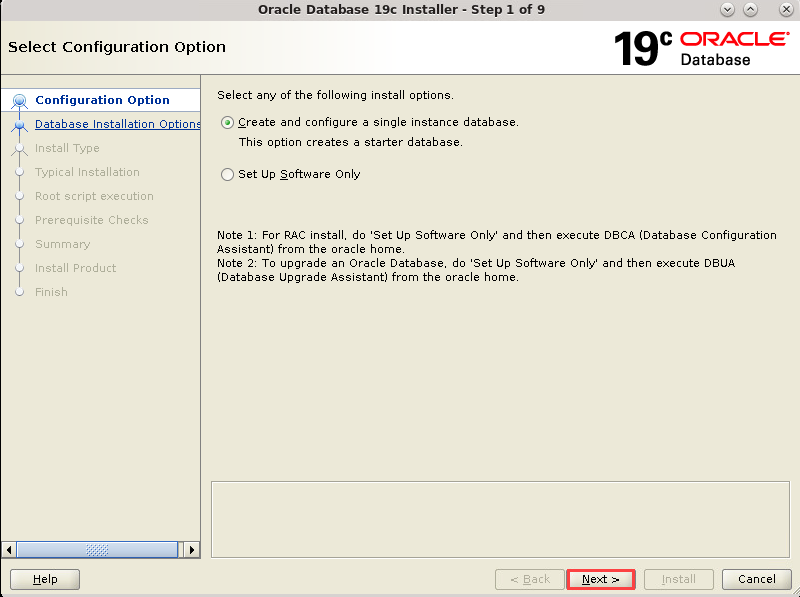
Description of the illustration db_3 - The system class window appears.
Select Desktop Class or Server Class depending on the type of
system you are using. In this scenario, we have chosen Server
Class. Click Next.

Description of the illustration db_4 - System Class window appears. Select
Desktop Class and click Next.
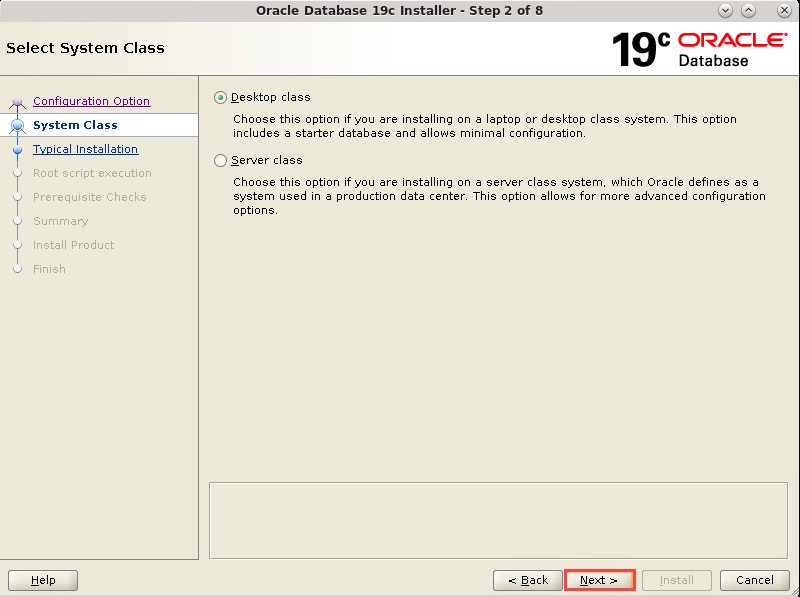
Description of the illustration db_4 - The Select Install Type window
appears. Select "Typical install." Click Next.

>Description of the illustration db_5 - The Typical Install
Configuration window appears. In the "Administrative
password" field, specify the password to be used for the
SYS, SYSTEM, SYSMAN, and DBSNMP accounts. (A warning is
displayed if the password does not meet oracle password
standards.) Make sure that the Create as Container
database option is selected as part of default
install settings and click Next.
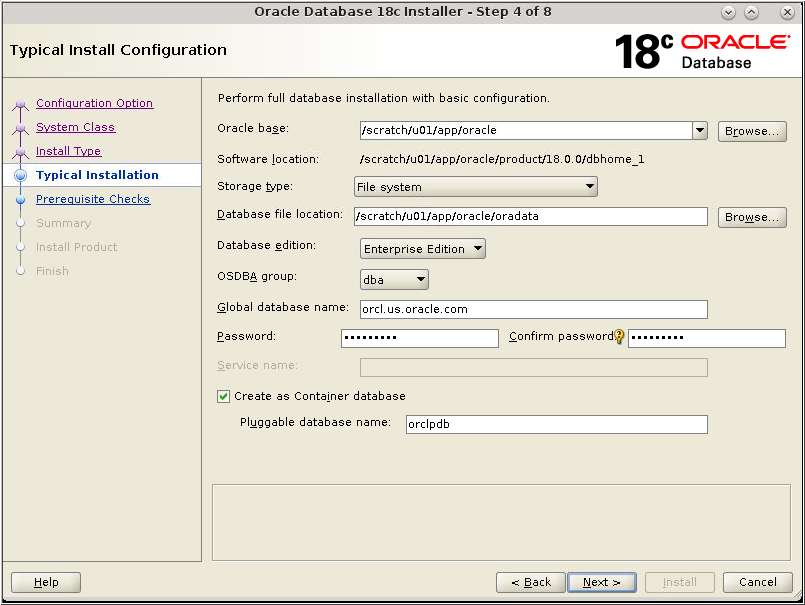
Description of the illustration db_6 Note: The Create as Container Database option is enabled to create the database as a CDB that can support zero, one, or many user-created PDBs. If you want DBCA to create a PDB when it creates the CDB, specify the PDB name in the Pluggable database name field.
- The Typical Install
Configuration window appears. In the "Administrative
password" field, specify the password to be used for the
SYS, SYSTEM, SYSMAN, and DBSNMP accounts. (A warning is
displayed if the password does not meet oracle password
standards.) Make sure that the Create as Container
database option is selected as part of default
install settings and click Next.
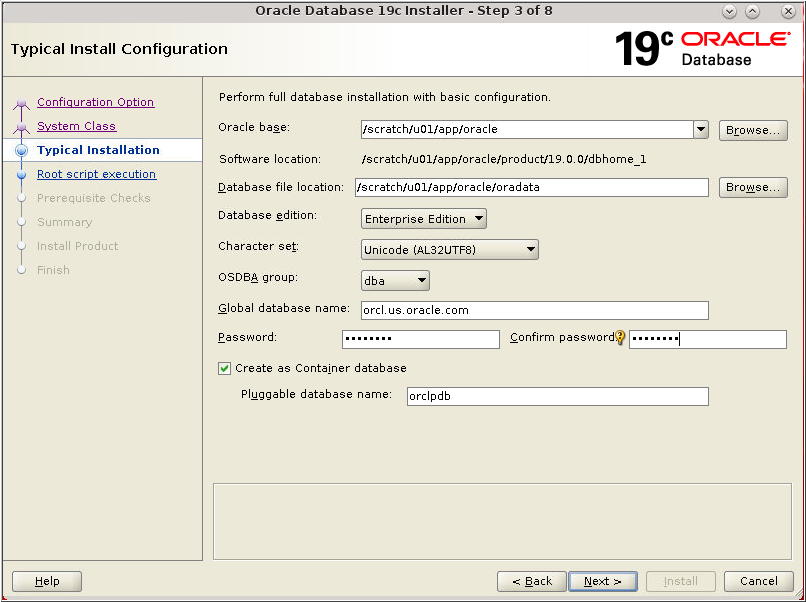
Description of the illustration db_6 Note: The Create as Container Database option is enabled to create the database as a CDB that can support zero, one, or many user-created PDBs. If you want DBCA to create a PDB when it creates the CDB, specify the PDB name in the Pluggable database name field.
- The Create Inventory window
appears. Accept the defaults and click Next.
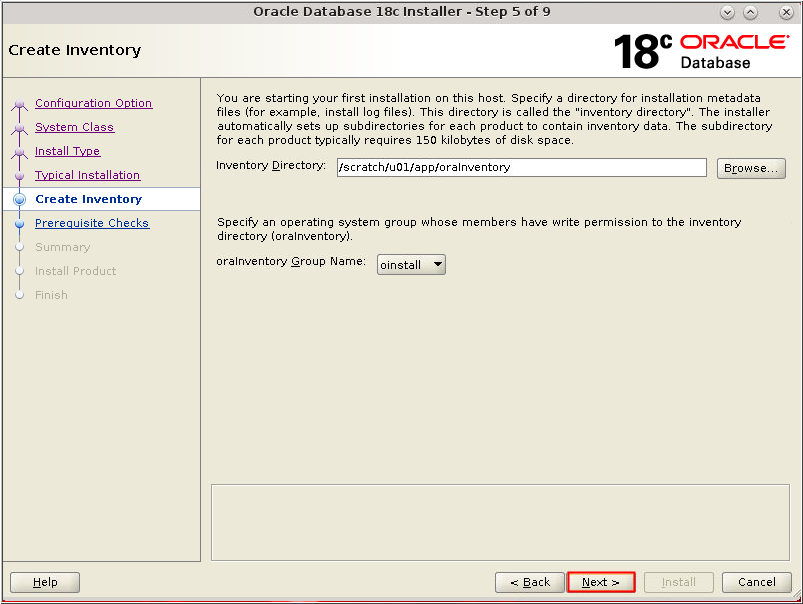
Description of the illustration db_7 - The Create Inventory window
appears. Accept the defaults and click Next.
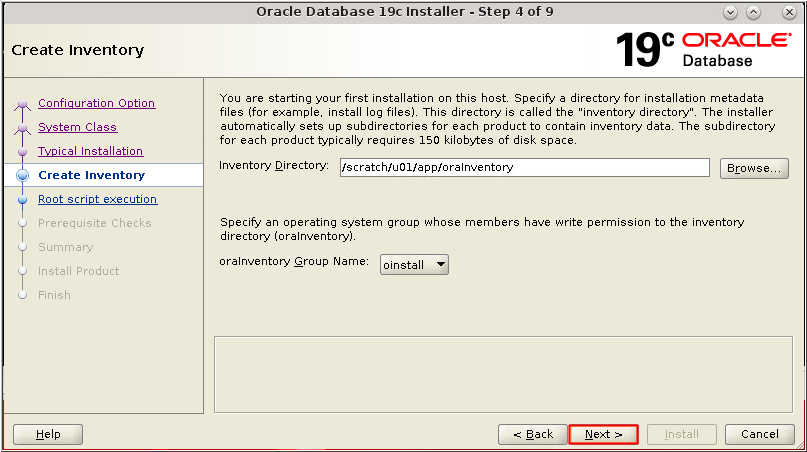
Description of the illustration db_7 - The Root script execute window
appears. For Linux and UNIX operating systems only, you are
prompted to run configuration scripts. To run root scripts
automatically, select Automatically run configuration scripts.
Alternatively, you can run the configuration scripts manually
as the root user. In this scenario, we have chosen to run the
configuration scripts manually. Click Next.

Description of the illustration db_8 - The prerequisite checks are
performed and a Summary window appears. Review the settings
and click Install.

Description of the illustration db_8 - The prerequisite checks are
performed and a Summary window appears. Review the settings
and click Install.
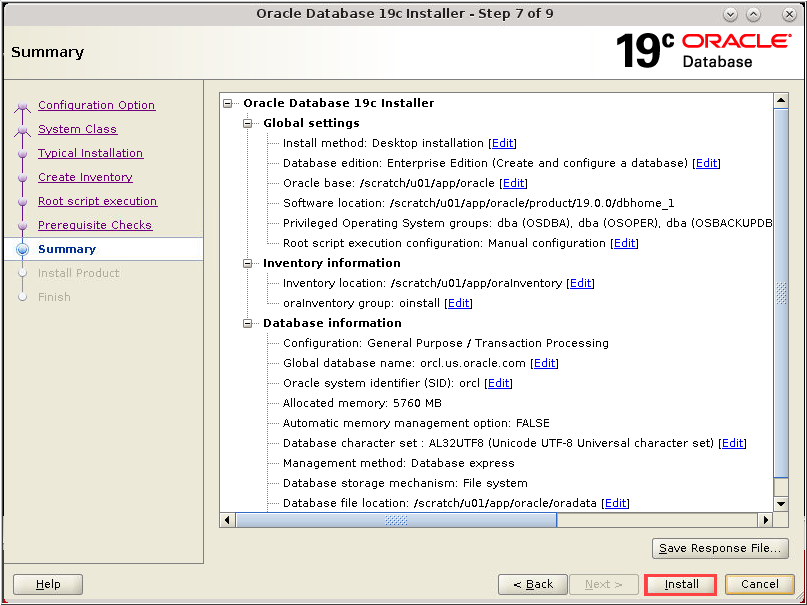
Description of the illustration db_8 - The progress window appears.

Description of the illustration db_9 - The progress window appears.

Description of the illustration db_9 - The Execute Configuration Scripts
window appears.

Description of the illustration db_10 - The Execute Configuration Scripts
window appears.

Description of the illustration db_10 - Open a terminal window and log in as the
root user. Execute the scripts as instructed. Close
your terminal window.
$ su - root Password: Enter password for root user $ /scratch/u01/app/oraInventory/orainstRoot.sh Changing permissions of /scratch/u01/app/oraInventory. Adding read,write permissions for group. Removing read,write,execute permissions for world. Changing groupname of /scratch/u01/app/oraInventory to oinstall. The execution of the script is complete. $/scratch/u01/app/oracle/product/18.0.0/dbhome_1/root.sh/scratch/u01/app/oracle/product/19.0.0/dbhome_1/root.sh Performing root user operation. The following environment variables are set as: ORACLE_OWNER= oracle ORACLE_HOME= $/scratch/u01/app/oracle/product/18.0.0/dbhome_1/scratch/u01/app/oracle/product/19.0.0/dbhome_1 Enter the full pathname of the local bin directory: [/usr/local/bin]: Enter Copying dbhome to /usr/local/bin ... Copying oraenv to /usr/local/bin ... Copying coraenv to /usr/local/bin ... Creating /etc/oratab file... Entries will be added to the /etc/oratab file as needed by Database Configuration Assistant when a database is created Finished running generic part of root script. Now product-specific root actions will be performed. Do you want to setup Trace File Analyzer(TFA) now ? yes|[no] : Enter Oracle Trace File Analyzer (TFA - User Mode) is available at : /scratch/u01/app/oracle/product/18.0.0/dbhome_1/suptools/tfa/release
/tfa_home/bin/tfactl/scratch/u01/app/oracle/product/19.0.0/dbhome_1/suptools/tfa/release
/tfa_home/bin/tfactl OR Oracle Trace File Analyzer (TFA - Daemon Mode) can be installed by
running this script : /scratch/u01/app/oracle/product/18.0.0/dbhome_1/suptools/tfa/release/tfa_home
/install/roottfa.sh/scratch/u01/app/oracle/product/19.0.0/dbhome_1/suptools/tfa/release/tfa_home
/install/roottfa.sh - After executing the scripts in your terminal window, return to the Execute Configuration scripts window and click OK.
- After the Database
Configuration Assistant creates the database, the Finish
window appears indicating the installation of Oracle
Database software and creation of the database was
successful. Click Close to exit the Oracle
Universal Installer.

Description of the illustration db_13 - After the Database
Configuration Assistant creates the database, the Finish
window appears indicating the installation of Oracle
Database software and creation of the database was
successful. Click Close to exit the Oracle
Universal Installer.

Description of the illustration db_13
 Perform
Basic Installation for Container Database
Perform
Basic Installation for Container Database